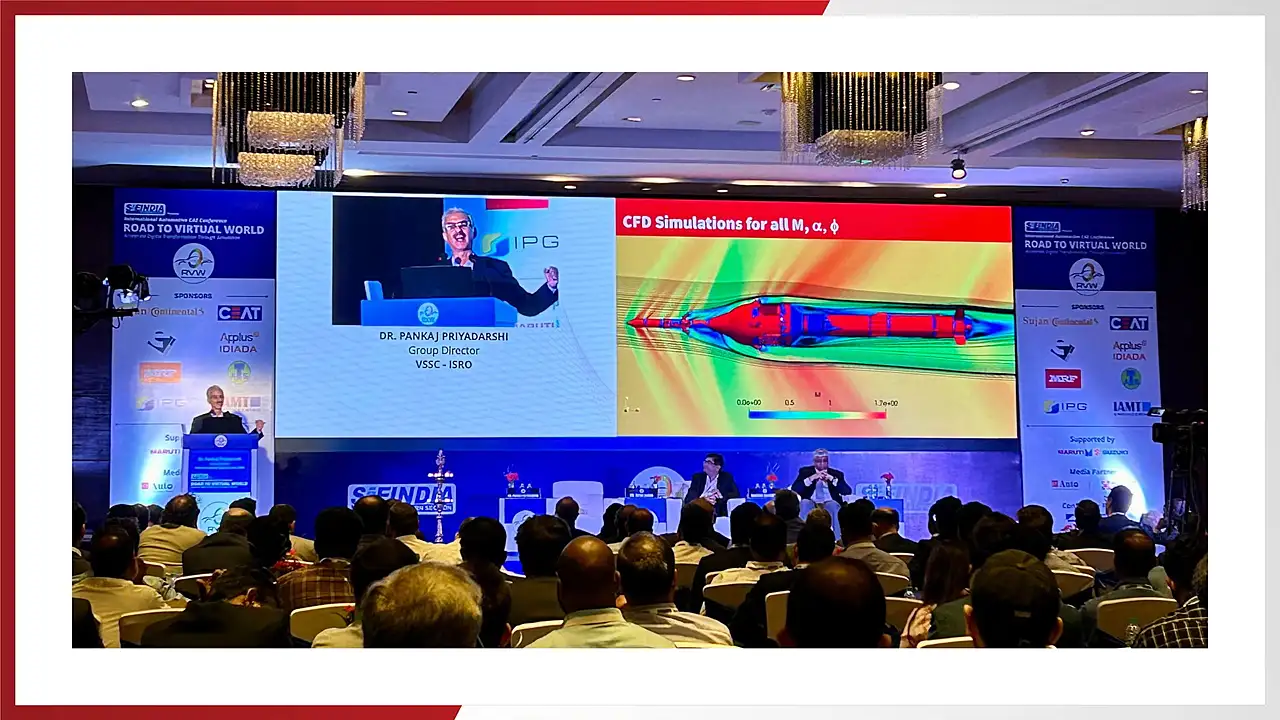
Whether designing a tiny spring bush in the suspension of an electric city runabout or plotting the trajectory of a satellite launch vehicle, simulation testing has become the bedrock of technology development. This message emerged from the SAE India-Northern India Section organised the International Automotive CAE Conference – Road to Virtual World’, which focused on accelerating digital transformation through simulation. With a versatile set of speakers from across the mobility industry, the message is clear: extensive utilisation of simulation development is fast-tracking the technology enhancement across every segment.
Simulation Testing In The Mobility Industry
The Government introduces many schemes to incentivise the manufacturing and sales of electric vehicles in the country. “As the consumer is very value conscious, we need to develop affordable products delivered in a short period of time,” stated Dr Tapan Sahoo, Executive Director (R&D), Maruti Suzuki India Ltd (MSIL). Him highlighting the quicker development of vehicles is backed up by the fact that simulation testing is considerably speeding up the model and component development. Skilling up and synergies between various automotive stakeholders have become the primary agenda as the scope, scale and speed of development for low-cost electric vehicles and alternate fuel vehicles are fast-tracking.
An interesting addition to this was given by Dr Pankaj Priyadarshi, who is the Group Director of VSSC – ISRO. He mentioned how the success of the Chandrayaan-3 mission required all the trajectory mathematics undergoing extensive simulation design, thus becoming the anchor for most hypotheses. “As aero-thermodynamic challenges increase, simulation testing becomes crucial for these calculations, something that the electric vehicle industry can take note of,” he added.
Multi-disciplinary design optimisation, digital twins, higher fidelity simulations and open-source development with partners will be the key to utilise simulation technology to the fullest. Penetration of virtual tech is much higher in the aerospace sector. The automotive sector can perhaps learn the reviewing strategies that ISRO utilises. The review mechanism involves asking each and every type of cross-question possible from all related stakeholders and addressing and proofing them in the application. The risk factors get discovered, and all stakeholders can benefit from this kind of cross-realisation of idea robustness.
Lightweighting is presumed to be what the automotive industry can learn from the space industry. However, the requirements for the automotive industry are completely different in terms of cost-effectiveness, as stated by Vishwanath Rao, MD, Altair Engineering India. The idea is to reduce cost and development time, which is where the idea of generative design will help. The aerospace industry is not yet mature with cost optimisation when it comes to virtual development.
Legislation and regulations also form a major part of this ecosystem. The necessities for involving cameras and radars need to be formulated for India to improve safety, which most European and American markets have achieved, said Dr Nagesh Poojary, Business Advisor, IPG. This will open doors for manufacturers to define and utilise simulation-based used cases and gather more data to improve vehicle safety. Policy stability is the need of the hour for implementing a long-term road map for the virtual development of vehicles.
Anything that moves in the future will be autonomous. Human intervention in mobility will be minimised. Since software-based updates are the only way forward, certification too is important, as vehicles cannot be bought on the road before that. This, too, is being leveraged by simulation testing heavily. This will also require seamless coordination with test agencies like ARAI and ICAT.
Moving forward, vehicles will be rating drivers based on their driving habits and this data can then be used to further design software solutions to increase efficiency. Kaushik Madhvan, Vice President-Mobility, MarketsandMarkets also said that predictive maintenance will be the highest revenue generator for auto manufacturers.
Implications For The Component Industry
Regarding EVs, the thermal problem can benefit hugely from simulation technology. Multiple scenarios tested in multiple configurations will increase the thermal stability of batteries in EVs. This is also a prime requirement for India as the temperature is higher than in Europe, the US or the Japanese markets. Prashant Rao, Director, Mathworks, clearly mentioned the need to increase simulation testing in the EV ecosystem.
“Tyre is the most complex product in the world,” said Renji Issac, SVP, CEAT. Simulation testing is being used so extensively in the tyre industry that it covers every aspect, from molecular level to tread design to emission to vehicle-mounted simulation testing. This is greatly aiding novel material development for the tyre industry. As tiny improvements, whether compounds or tread patterns are tricky to achieve, simulation testing is a better solution than laborious laboratory experiments.
Further, polymer blending is a successful use case as finding the correct compatibility between blends is difficult to achieve. Simulation is a very useful tool for quantitatively predicting material behaviours as well. Although simulation is computationally expensive, a deep theoretical understanding of the theory is required. However, it is still a useful alternative to lab and prototype experiments.
Enric Aramburu, Product Manager, Applus IDIADA, spoke from the AI the perspective that as machine learning and neural networks enhance the capability of AI, ‘real-time’ computation for aerodynamics and crash testing simulation modelling is the upcoming powerhouse of development. Aerodynamics simulation working through geometric deep learning is returning results as good as wind tunnel testing.
The pressure is increasing on manufacturers to bring electric vehicles to the market at a quick rate. Building a prototype is quicker than designing a simulation; however, the testing iterations and modification can be done endlessly with simulation, making it significantly quicker as a process. Additionally, simulation platforms can also share information about different products by different manufacturers, thereby making simulations with different components seamless.
Also Read